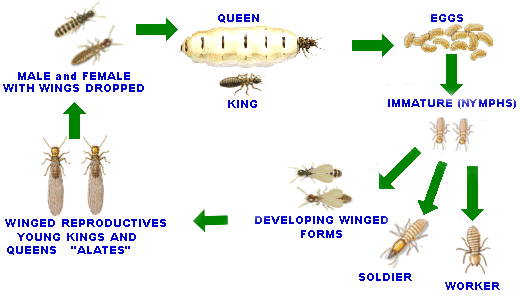Area of Distribution: West Indian powderpost termites are found mainly
in the humid coastal areas of the southern states of the United States
from Virginia to Florida, through the desert southwest, along the Pacific
coast to northern California and in Hawaii.
West Indian powderpost termites are sometimes discovered in other states
after being transported in furniture or other timbers.
West Indian powderpost termites infest the structural timbers of buildings,
furniture and other dry timbers having less than 12% timber moisture
content. This termite species require no ground contact and obtain their
required moisture intake from the timber they infest.
West Indian powderpost termites are sometimes called "powderpost"
termites or "furniture" termites due to their small faecal
droppings and the fact that they commonly attack timber furniture. The
average moisture content of seasoned timbers in service in the United
States is 8-12%, except along the coastal plains where the moisture
level can exceed 12%.
Identification of Swarmers and Soldiers: Swarmers are about 7/16-1/2"
long including the wings, with the head width being 1/32-1/16".
The head and body are pale yellowish brown to pale reddish brown and
the wings are hardened and pigmented. The veins are pale yellowish brown
in the outer half of the wing.
The front wings have 3 dark, heavily sclerotized veins in the front
half of the wing. The median vein is un-sclerotized and runs midway
between sclerotized veins above and unsclerotized area below. The area
ends near the wing tip even if branched along its length and is not
hairy. The tibia have spines lacking along their length, apex has 3
spines.
The head of the West Indian powderpost termite soldier is short and
thick in front, the front surrounded by a flange and the front part
nearly black. Mandibles re-curved under front of head, with an unequal
number of teeth on each member of pair. The tibia lacks spines along
length.
Identification of Timber Damage: The most obvious sign of infestation
is the piles of tiny faecal pellets ejected through temporary holes
in the infested timber. The faecal pellets are hard, elongated and oval
with rounded ends, and have six concave sides.
West Indian powderpost termites eat across the wood grain and make chambers
or galleries connected by tunnels. Other signs of infestation include
the presence of swarmers or their shed wings, piles of faecal pellets,
termite plugs which seal all openings in infested wood, and surface
blisters caused by older enlarged galleries very close to the wood surface.
Occasionally they may build shelter tubes constructed of pellets cemented
together to bridge over to an adjacent piece of wood.
Biology and Habits: West Indian powderpost termites do not live in the
ground. They obtain all the moisture required from the timber they infest.
They do not require contact with the ground and do not build mud shelter
tubes.
Their colonies are located in the wood they eat and are small in size,
containing perhaps a few thousand termites. It is commonplace to have
multiple colonies in the same building.
West Indian powderpost termite infestations tend to be localised in
buildings, in doors, window trims, fascias, even picture frames. They
eat the springwood as well as the summerwood. The cavities they excavate
in timbers are clean and smooth, and do not contain any mud packing,
in contrast with subterranean termites.










